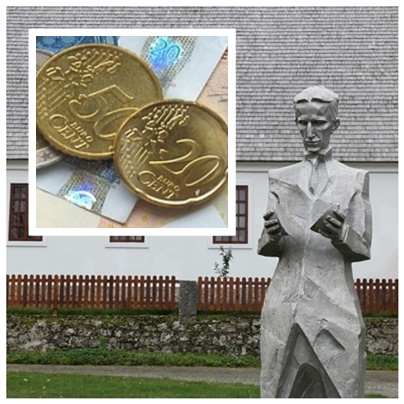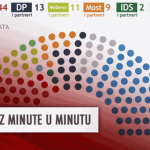The announcement of five motifs chosen to grace the national side of Croatian euro coins that came last Wednesday was soon greeted by a statement on the official website of the National Bank of Serbia. In it, NBS objects to the Croatian idea of using the image of Nikola Tesla. It’s described as ”an appropriation of the cultural and scientific heritage of the Serbian people.” Serbia also stated it would file a complaint if Croatia put his image on one of the coins.
The question is, to whom would these complaints be filed, and to what effect? Is there a set legal way to get Croatia to remove Tesla from the coins not yet minted? (Un)surprisingly, there are a few precedents guarding the question, as this is not the first time that one country objected to the design of another country’s euro coins, claiming it belonged to its own national heritage.
In 2005, Slovenia’s use of the Prince’s Stone on the 2 cents coins launched a protest from the Austrian state of Carinthia. Prince’s Stone is an ancient Roman column that was used during the early Middle Ages in the ceremony of installing the rulers of the Slavic principality of Carantania. The ceremony was conducted in the Slovene language, and Caranthania was located, in part, on the territory of present-day north-eastern Slovenia. The stone itself used to be kept in a museum in Klagenfurt, the capital of Carinthia, where it was considered a historical icon of the state. The Carinthian state government (headed by the then-governor Jorg Haider) issued a resolution of protest on October 25, 2005, which was rejected as “not to be taken seriously” by the Slovene foreign minister Dimitrij Rupel.
Ten years later, in 2015, Belgium issued a €2 commemorative coin (individual Member States are allowed to issue commemorative coins to celebrate subjects of major national or European relevance). To mark the Battle of Waterloo, and the 200th year anniversary of the defeat of Napoleon, the coin featured an image of the monument at the site. France objected, saying that the image carried a negative connotation.
According to the COUNCIL REGULATION (EU) No 729/2014 on denominations and technical specifications of euro coins intended for circulation, when a eurozone country wants to issue a new €2 commemorative coin, it is required to send a draft design of the coin to the Council, the European Commission and to other eurozone countries. In the end, as RFI wrote in 2015, ”Brussels has been forced to scrap 180,000 coins worth 1.5-million-euros that it had already minted before Paris got wind of the affair.”
And in 2013, Slovakia re-thought its idea of issuing commemorative coins with the images of Christian saints and missionaries Cyril and Methodius with crosses and halos above their heads, as some Member States pointed out that the designs went against the ”principle of respect for religious diversity in Europe”.
However, all of these disputes were started and resolved between the EU Member States, not a Member State and a third country, as is the case with Serbia. As European Commission Deputy Chief Spokesperson Dana Spinant said on Friday, ”the design of the national side of euro coins is decided by the country adopting the euro.”
The designs have to be passed from the Croatia National Bank to the National Council for the Introduction of the Euro for approval and then have to be confirmed by the government of Croatia.
That doesn’t mean that the design lays solely in Croatia’s hands.
The abovementioned Council Regulation also states that ”each Member State (….) should take into account the fact that euro coins circulate in the whole euro area and not only in the issuing Member State”, and should ”avoid the use of inappropriate designs”.
Recognizing the potential problem when it comes to defining the term ”inappropriate” the Regulation states that ”uniform conditions” for the approval of the designs should be laid down and also that ”in view of the fact that the competence for an issue as sensitive as the design of the national sides of the euro coins belongs to the issuing Member States, implementing powers should be conferred on the Council.”
Therefore, Croatia has to submit draft designs to the Council, to the Commission, and to the other Member States whose currency is the euro at least three months before the planned issue date. Since Croatia is set to enter the eurozone in 2023, that criterion shouldn’t be difficult to meet.
Within seven days following the submission, any Member State whose currency is the euro may, in a reasoned opinion addressed to the Council and to the Commission, raise an objection to the draft design proposed by the issuing Member State if that draft design is likely to create adverse reactions among its citizens.
If the Commission considers that the draft design does not respect the technical requirements set out by the Regulation, it shall, within seven days following the submission, submit a negative assessment to the Council.
If no reasoned opinion or negative assessment has been submitted to the Council, the decision approving the design shall be deemed to be adopted by the Council.
In all other cases, the Council shall decide without delay on the approval of the draft design, unless, within seven days following the submission of a reasoned opinion or of a negative assessment, the issuing Member State withdraws its submission and informs the Council of its intention to submit a new draft design.
Since there are essentially two criteria to meet – the suitability of the design requirement and the technical requirement, both assessed by other Member States (the EU), the only tool any country outside of the EU can use is its political influence on a Member State to try and come up with a reasoned opinion as to why a draft design is ”likely to create adverse reactions” – but only among its (a Member State’s) citizens.
There is nothing in the Regulation on the influence the design may have on the non-EU countries. In fact, the Regulation even makes sure to point out that the other Member States whose currency is not the euro are excluded from deciding. Will Croatia be able to keep Tesla on its coins? If these provisions are anything to go by, then yes.
For more on politics, CLICK HERE.








